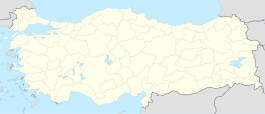Antalya (Turkish pronunciation: [anˈtalja]) is the eighth most populous city in Turkey and the capital of its eponymous province. Located on Anatolia's flourishing southwest coast bordered by the Taurus Mountains, Antalya is the largest Turkish city on the Mediterranean coast with over one million people in its metropolitan area.[2][3]
The city that is now Antalya was first settled around the 200 BC by the Attalid dynasty of Pergamon, which was soon subdued by the Romans. Roman rule saw Antalya thrive, including the construction of several new monuments, such as Hadrian's Gate, and the proliferation of neighboring cities. The city has changed hands several times, including to the Byzantine Empire in 1207 and an expanding Ottoman Empire in 1391.[4] Ottoman rule brought relative peace and stability for the next five-hundred years. The city was transferred to Italian suzerainty in the aftermath of World War I, but was recaptured by a newly independent Turkey in the War of Independence.
Large-scale development and governmental funding has promoted tourism. A record 12.5 million tourists passed through the city in 2014.

Antalya - Go Turkey Official Tourism Portal of Turkey

Antalya (Turkish pronunciation: [anˈtalja]) is the eighth most populous city in Turkey and the capital of its eponymous province. Located on Anatolia's flourishing southwest coast bordered by the Taurus Mountains, Antalya is the largest Turkish city on the Mediterranean coast with over one million people in its metropolitan area.[2][3]
The city that is now Antalya was first settled around the 200 BC by the Attalid dynasty of Pergamon, which was soon subdued by the Romans. Roman rule saw Antalya thrive, including the construction of several new monuments, such as Hadrian's Gate, and the proliferation of neighboring cities. The city has changed hands several times, including to the Byzantine Empire in 1207 and an expanding Ottoman Empire in 1391.[4] Ottoman rule brought relative peace and stability for the next five-hundred years. The city was transferred to Italian suzerainty in the aftermath of World War I, but was recaptured by a newly independent Turkey in the War of Independence.
Large-scale development and governmental funding has promoted tourism. A record 12.5 million tourists passed through the city in 2014.
antalya-06.jpg
Antalya - Go Turkey Official Tourism Portal of Turkey
Antalya coastline, Turkey : Layover Guide
Antalya Turkey. Antalya, Kemer, Belek, Lara, Side, Alanya ...
Happy Cave Travel • Antalya
Antalya Hotels - 98 hotels in Antalya | Hotelopia
Waterfront Property For Sale in Antalya | Buy A Home, Apartment Or ...
 Antalya (Turkish pronunciation: [anˈtalja]) is the eighth most populous city in Turkey and the capital of its eponymous province. Located on Anatolia's flourishing southwest coast bordered by the Taurus Mountains, Antalya is the largest Turkish city on the Mediterranean coast with over one million people in its metropolitan area.[2][3]
Antalya (Turkish pronunciation: [anˈtalja]) is the eighth most populous city in Turkey and the capital of its eponymous province. Located on Anatolia's flourishing southwest coast bordered by the Taurus Mountains, Antalya is the largest Turkish city on the Mediterranean coast with over one million people in its metropolitan area.[2][3]






